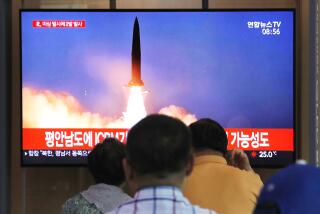Estimate of Post-Chernobyl Cancer Toll Lowered
- Share via
VIENNA — Soviet and Western scientists agreed Thursday that initial estimates that 24,000 Soviet citizens might eventually die from cancer as a result of the Chernobyl nuclear accident probably overstated the long-term health effects and that the actual toll may be closer to 5,000 over the next 70 years.
The lower number, while significant, would be statistically invisible amid the 9.5 million cancer deaths expected from other causes in the same period among the 75 million people living in affected areas of the Soviet Union, the scientists said.
The revised estimate of possible deaths emerged from continuing technical discussions between Soviet scientists and researchers from 46 other countries, meeting in Vienna under the auspices of the International Atomic Energy Agency to study the Chernobyl accident four months ago.
The explosion and fire that destroyed the 1,000-megawatt reactor north of Kiev released an estimated 50 million curies of radioactive wastes that produced detectable contamination over much of the Northern Hemisphere.
No Outside Estimate
IAEA officials said that the World Health Organization is still compiling information on levels of contamination beyond Soviet borders, and that no authoritative estimate was available yet of potential health effects outside the Soviet Union.
For the Soviets, the most worrisome contaminant is cesium-137, a long-lived component of fission wastes that moves readily through soil and into the food chain through the roots of grain, potatoes and other food crops.
The lower estimate of potential cancer deaths came during discussions Thursday in which several Western scientists, prominent in setting international radiation protection standards, urged the Soviets to recalculate the internal radiation dosage they expect people to receive from cesium in affected areas of the Ukraine, Byelorussia and the Russian Republic.
The presence of sandy soils in these areas, in which cesium tends to migrate to plant roots 10 to 100 times faster than normal, made the health risk seem particularly great.
Average Radiation Dose
The Soviets estimated that the 75 million people living in these areas would eventually receive an average radiation dose of 2.8 rems from a lifetime of ingesting tiny amounts of cesium, for a collective population dose of 210 million man-rems.
A rough but widely accepted rule of thumb among radiation health specialists holds that every 10,000 man-rems of exposure can be expected to produce one cancer death over a lifetime period, or in the case of 210 million man-rems, 21,000 deaths.
“We thought this 210-million figure was very unlikely to be realistic, by a factor of 10,” Dr. Dan Beninson, the chairman of the International Commission on Radiological Protection, told a news conference after daylong discussions with Soviet experts. Journalists have been barred from attending the meetings.
“We found this was meant to be a maximum number, that the Soviets used the most conservative assumptions at every point,” Beninson said. “When we asked why, they said it was to be on the safe side.”
‘Not Realistic’
Beninson, whose organization has played a major role in setting worldwide radiation standards since the 1920s, said that “the 210 million is not an impossible number, but it is not a realistic estimate.”
A population dose one-tenth this magnitude implies only about 2,000 eventual deaths. To these are added an estimate of 3,000 more from long-term exposure to contaminants in the general environment for a possible total of 5,000.
“In reality this is all nonsense, a numbers game,” Beninson insisted, because such estimates contain a number of theoretical assumptions about the linkage between radiation dose and cancer risk that may never be provable.
More to Read
Sign up for Essential California
The most important California stories and recommendations in your inbox every morning.
You may occasionally receive promotional content from the Los Angeles Times.









